 So I first discovered the wonders of Margaret Mahy back in April, and immediately fell in love and began working my way through her books. There are a lot of them, and I actually find it’s best not to try reading them in close succession, so I still have a ways to go.
So I first discovered the wonders of Margaret Mahy back in April, and immediately fell in love and began working my way through her books. There are a lot of them, and I actually find it’s best not to try reading them in close succession, so I still have a ways to go.
I did want to post though, about two of her early books that I recommend to any and everyone who has any vague interest in prose strange enough to take your head off and put it back on again differently oriented or in, well, excellent YA novels. I know several people read The Changeover after I briefly posted about it earlier this year (which was extremely happy-making), and I hope anyone who wasn’t convinced will be after this post, and will add The Catalogue of the Universe and some other Mahy’s to their queue too. I also know that Mahy is a huge star in other parts of the world–as she should be!–but she seems way underknown here, which is unfortunate. And this connects up with yesterday’s post about Elizabeth Knox; both these authors are from New Zealand, and I believe the dedication in Knox’s second book is to Mahy herself (I’m hoping to ask her about whether I’m right in an interview later this year).
One of the thing that absolutely floors me about Mahy’s work is the way in which she never makes the usual or easy decision, but always manages to make the one that best supports the entire book and what she’s trying to do. Okay, could I make that sound any less interesting? In reality, it’s fascinating.
In The Changeover, for instance, Mahy demonstrates a particular fascination for the process of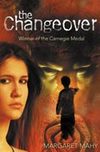 change–the in-between stage when a character is caught between the old thing and the next thing they will become. All the major characters in the novel possess this interstitial quality in some key way. Protagonist Laura Chant seems to be in transition from the novel’s opening, when she hears a voice warn her vaguely that "It’s going to happen." Whatever "it" is, Laura is now suspended, waiting for its arrival. Soon, that promised change materializes in the guise of a mysterious shopkeeper, Carmody Braque, a revenant who marks her younger brother Jacko’s hand in order to drain away his life force. Jacko is trapped between life and death for the rest of the novel, ebbing ever closer to losing his identity. Laura herself is a "sensitive," accounting for the voice, and so inhabits a space apart from those around her and yet as one of them. She knows she must go to classmate Sorenson "Sorry" Carlisle for help, because she can tell he is a witch. He lives in the big old house with three witches (like him, but older, wiser), who reveal that Sorry is not exactly settled himself–he is a rare male witch, and they worry that in the process of becoming so, he has lost his humanity. The cast of major players is rounded out by Laura’s single mother and a fragile but promising new love interest; their relationship and whether it will last through the book becomes a mystery.
change–the in-between stage when a character is caught between the old thing and the next thing they will become. All the major characters in the novel possess this interstitial quality in some key way. Protagonist Laura Chant seems to be in transition from the novel’s opening, when she hears a voice warn her vaguely that "It’s going to happen." Whatever "it" is, Laura is now suspended, waiting for its arrival. Soon, that promised change materializes in the guise of a mysterious shopkeeper, Carmody Braque, a revenant who marks her younger brother Jacko’s hand in order to drain away his life force. Jacko is trapped between life and death for the rest of the novel, ebbing ever closer to losing his identity. Laura herself is a "sensitive," accounting for the voice, and so inhabits a space apart from those around her and yet as one of them. She knows she must go to classmate Sorenson "Sorry" Carlisle for help, because she can tell he is a witch. He lives in the big old house with three witches (like him, but older, wiser), who reveal that Sorry is not exactly settled himself–he is a rare male witch, and they worry that in the process of becoming so, he has lost his humanity. The cast of major players is rounded out by Laura’s single mother and a fragile but promising new love interest; their relationship and whether it will last through the book becomes a mystery.
I mention all these people, because one of the other things Mahy’s a master at is capturing unique family dynamics. The adults in these book are adults, with their own lives and concerns and imperfections. They have a bearing on the story, but without taking it away from the younger protagonists. It seems to me this is a much more accurate–and interesting–reflection of reality than the "parents and adults always off stage" that much YA traffics in.
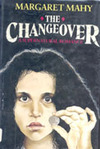 These characters are all peculiarly situated to bring on the transition of the title, the process through which Laura will become a witch in the course of her dealings with the Carlisles, trying to save her brother Jacko and her mother’s happiness. The "changeover" itself takes only a chapter, and comes close to the end of the book. Much more time is spent examining the oddness of what is happening to Jacko and Laura’s position and options. She is a character on the cusp of many things. Her burgeoning sexuality and attraction to Sorry is one, and in many ways her "changeover" is symbolized by her romantic embrace of the older Sorry, her transition to womanhood in the traditional sense.
These characters are all peculiarly situated to bring on the transition of the title, the process through which Laura will become a witch in the course of her dealings with the Carlisles, trying to save her brother Jacko and her mother’s happiness. The "changeover" itself takes only a chapter, and comes close to the end of the book. Much more time is spent examining the oddness of what is happening to Jacko and Laura’s position and options. She is a character on the cusp of many things. Her burgeoning sexuality and attraction to Sorry is one, and in many ways her "changeover" is symbolized by her romantic embrace of the older Sorry, her transition to womanhood in the traditional sense.
Mahy enforces this emphasis on transition and transformation through the very way she paces sentences, chapters, and paragraphs on the page. The rush of story is heady and odd. It is precisely the speeding up and slowing down of action, the focus on the in-between scenes that turn into focal points after all, that makes the entire novel so strange and unsettling. By using these unusual transition points, our experience of the story is controlled by Mahy in such a way that we feel the discomfort the characters feel, trapped in it themselves. We are not free to have a lazy experience. We are caught between one thing and another and will not stop until fixed.
She performs similar micro and macro alchemy in The Catalogue of the Universe to an entirely different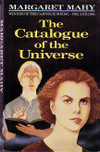 end. Catalogue isn’t a fantasy novel at all, but it sure as hell feels like one. It’s one of the strangest books I’ve ever read, and possibly the most pleasantly strange. Like The Changeover, in many ways Catalogue could be pigeonholed as a romance. It’s the story of an unlikely pair of lovers, who start the book as friends(I don’t think I’m giving anything away here)–the beautiful and witty Angela May and the brilliant but nerdy Tycho Potter.
end. Catalogue isn’t a fantasy novel at all, but it sure as hell feels like one. It’s one of the strangest books I’ve ever read, and possibly the most pleasantly strange. Like The Changeover, in many ways Catalogue could be pigeonholed as a romance. It’s the story of an unlikely pair of lovers, who start the book as friends(I don’t think I’m giving anything away here)–the beautiful and witty Angela May and the brilliant but nerdy Tycho Potter.
Mahy dizzingly plays within scenes, showing us the swirl of activity in Tycho’s household and the oddness in Angela’s. Here’s a bit from the opening that will show what I mean (Mahy is a master of the long, luxurious paragraph as well), where Angela has gotten up at night and is walking around with her eyes closed. She hears a noise and decides to check it out:
As she stood, simply feeling grateful, she heard for the third time, beyond all doubt, a sound outside, a sound so soft that it would have been possible to think it out of existence again, except that this time she really knew she had heard it, a sound as gentle as a hand brushing down a velvet curtain. It made her curious but it did not alarm her, for she was used to many different sounds in the night, living as she did up above the city, in a wild place close under the sky. She went to her window and looked out, and there in the bright moonlight she saw her mother Dido in the centre of the square of grass half-contained in the right angle made by their odd home (a home that had never quite got as far as being a proper house). It took a moment to realize what Dido was doing, but that rhythmic and dreamy sway was familiar–Dido was scything the grass by moonlight. Angela could see the entranced, semi-circular swing of her shoulders, heard the whisper of the keen steel and the sigh of long grass bowing down before her. Everything around her was drenched in a light so clear and so intense it seemed as if it must have more substance than ordinary light. It was the very light of visions and prophecies.
Okay, I don’t know about you, but I can’t remember the last time I encountered a scene so strange at the beginning of a novel which wasn’t strangeness for strangeness’ sake. Catalogue’s plot follows Angela as she confronts the man she has discovered is her father, and then realizes her true feelings for Tycho (and her mother). It is about the immensity of the universe and finding a place in it anyway.
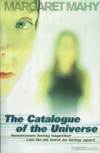 Mahy dips in and out of various points of view (including the cat’s head for a moment at one point, but never those of the adults) in a way that supports the romance of two young people swept up in the expansiveness of the universe. The feeling that the narrator can burrow down to the cat’s level, or hover out at the length of a star, is appropriate to the romantic nature of the story. The book itself is named for a book within the text. And oh, the conversations of Angela and Tycho, about anything and everything, theory and postulation that captures the very essence of what it means to be a certain kind of slightly obsessed, bright teenager. This is a story about philosophy, astronomy, and love, and not one to be missed.
Mahy dips in and out of various points of view (including the cat’s head for a moment at one point, but never those of the adults) in a way that supports the romance of two young people swept up in the expansiveness of the universe. The feeling that the narrator can burrow down to the cat’s level, or hover out at the length of a star, is appropriate to the romantic nature of the story. The book itself is named for a book within the text. And oh, the conversations of Angela and Tycho, about anything and everything, theory and postulation that captures the very essence of what it means to be a certain kind of slightly obsessed, bright teenager. This is a story about philosophy, astronomy, and love, and not one to be missed.
These two novels were both published in the mid- to late-1980s. The thing that floors me is that while, yes, there are some things that feel slightly dated in them here and there, for the most part they feel more modern than much of the traditionally structured fiction I see now. Regardless, they hold up beautifully. So I could basically have skipped all this and gotten to the point: Margaret Mahy is a genius. Read these books.
And today’s other Radar recommendations are (courtesy of Colleen):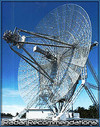
A Chair, A Fireplace & A Tea Cozy: Friends for Life and Life Without Friends both by Ellen Emerson White
Big A, little a: A interview with Helen Dunmore
Jen Robinson’s Book Page: The Treasures of Weatherby by Zilpha Keatley Snyder
Bildungsroman: Swollen by Melissa Lion
Finding Wonderland: Lucy the Giant by Sherry L. Smith
Miss Erin: A discussion of Erec Rex: The Dragon’s Eye and an interview with author Kaza Kingsley
Seven Impossible Things Before Breakfast: An interview with Nancy Crocker, author of Billie Standish Was Here
Fuse Number 8: The Noisy Counting Book by Susan Schade (ed. note: I really loved The Travels of Thelonious too!)
Chasing Ray: Juniper, Genetian and Rosemary by Pamela Dean
lectitans: Who Pppplugged Roger Rabbit? by Gary K. Wolf
Writing and Ruminating: Hugging the Rock by Susan Taylor Brown
Semicolon: Overlooked Christian fiction
Thank you for this. I have always loved Mahy’s work ,but somehow haven’t read any recently. While I really love the books that she writes for young adults, like those you have discussed here, one of the most remarkable things about her is the way in which she is able to write for all ages. Have you read any of her comic short stories for younger children? Do try ‘The Librarian and the Robbers’; it is superb.
“Catalogue” is one of my all time favorite books. I was so thrilled years ago when I found a paperback copy I could buy (I think it went oop in the US for awhile.)
What really hooked me was who Tycho was named for and how he talked about astronomy – how he really loved it. And how loyal he was and just how perfect they were for each other.
This story is magic, pure and simple; I’m quite delighted that you love it too!
I need to read more Mahy. Thanks for the reviews, Gwenda.
I swear I know the girl on that first Changeover cover illo.
Thank you so much for this fabulous analysis of two of Mahy’s best books. I first read The Changeover in the mid-1980’s, and have gone back to it over and over as I’ve aged (I’m 31 now), and still find it a fascinating and entertaining read. Your discussion here has only enhanced that.
I’ve never read anything by Mahy, and because of this post I will, so thank you for calling her to my attention.
UNDER THE RADAR???? Does the Hans Christian Anderson Award mean nothing to Americans? This is unbelievable ignorance – you should all go out and read all her books immediately! http://library.christchurch.org.nz/MargaretMahy/Awards/
I’ve been trying to remember the name of this book forever! I read it when I was in middle school, and kept thinking it was called “The Changeling”. Well I was sort of close. Thanks for reminding me of a great book, and I’ll have to read her other books too!
hey just a question do you know what her frist book was im doing a school project???
thanks